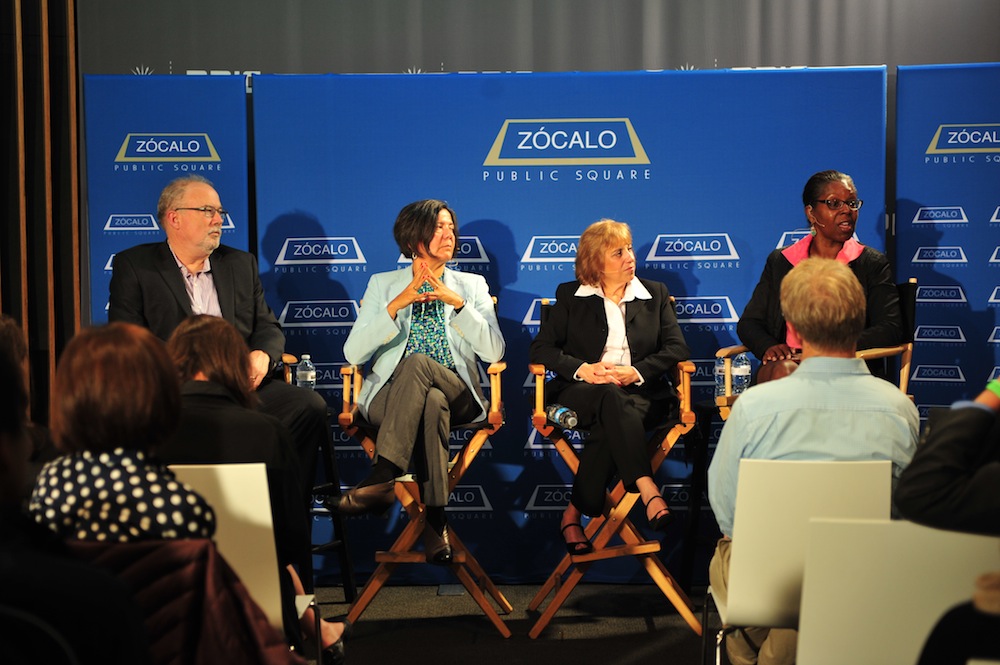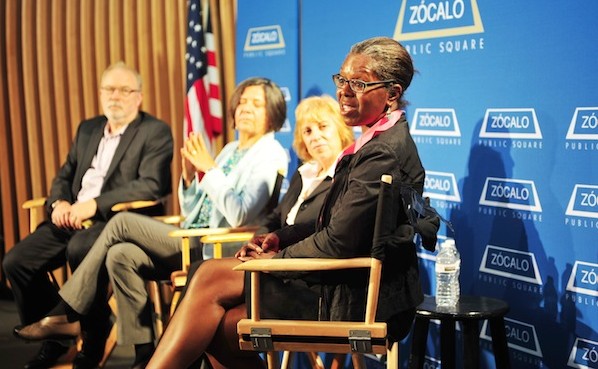
Before Obamacare became part of the American lexicon—before Barack Obama had been elected president—San Francisco implemented healthcare reform of its own. What can Healthy San Francisco, which launched in 2007 to subsidize medical care for the city’s uninsured, teach the rest of the country? At an event co-presented by The California Wellness Foundation at PPIC in downtown San Francisco, California HealthCare Foundation president Sandra Hernández, former Healthy San Francisco director Tangerine Brigham, and HR Ideas CEO Deisy Bach looked at the city’s past in order to better understand the country’s healthcare future.
Hernández, who worked to launch and implement Healthy San Francisco as CEO of the San Francisco Foundation, pointed to three aspects of the program that made it a success. First, all of the players were at the table when Healthy San Francisco was built—not just the advocates or the payers but everyone, from major hospital systems to small businesses. Second, their goal was clear: Everybody “would enroll in a very simple process that would give them a medical home.” That meant having a primary care doctor, or a place to go for preventive care and to manage chronic diseases outside hospitals and emergency rooms. The third key to the program’s success was that everyone had to pay into the system in some way.
Has paying for Healthy San Francisco been an onerous burden on businesses? Healthy San Francisco and the San Francisco Health Care Security Ordinance required employers with a minimum of 20 employees to spend money on healthcare coverage for anyone working as few as two hours per week. The local restaurants that Deisy Bach works with raised a number of questions about that requirement. The city of San Francisco is surrounded by cities with lots of businesses that don’t have the same expenses, she said. On top of that, the restaurant industry is seasonal; as a result, the administrative costs of dealing with high levels of turnover are heavier.
However, said Hernández, it’s important to remember: “Small businesses want their employees to have access to care and ultimately have insurance.” Businesses don’t want an uninsured workplace; they’re concerned about how to pay for an insured workplace and how to comply with laws.
San Francisco Business Times reporter Chris Rauber, the evening’s moderator, asked Tangerine Brigham for her take on the big question of the night—lessons that can be drawn from San Francisco in the national implementation of the Affordable Care Act (ACA).
Brigham said that a big difference between Healthy San Francisco and the ACA is that Healthy San Francisco did not set out to spend a lot of money on administrative and outreach costs. There wasn’t a budget for bus ads, brochures, and fliers.
“Enrollment in San Francisco was very grassroots,” said Hernández—it was about in-reach, not outreach, and utilizing clinics and systems that were already in place.
Brigham said that the goal of the program was to create a system that was simple for both individuals and providers to use. And she said that it was important in San Francisco—as it will be for the rest of the country—to collect data showing that the health status of people participating in the program improved.
Healthy San Francisco looked at emergency room utilization for the city’s uninsured population for the two years prior to the program’s start and two years after in comparison to the rest of California. “We were able to show it went down during Healthy San Francisco, and at every other public hospital, it went up,” she said. People in the program “didn’t have to go to emergency rooms. They had someone they could call, they had a card, and they used it.”
This was key to the program getting every major hospital system to participate.
Prior to Healthy San Francisco, said Hernández, uninsured patients with diseases that shouldn’t be treated in the ER were showing up in emergency rooms “and causing all kinds of diversions and clogs in that delivery system.” Plus, the hospitals weren’t getting compensated. The question of whether or not the ACA will get people care in the right place has not yet been answered, she said, adding, “having an insurance card if you can’t get in to see a provider does not solve the problem we set out to solve with Healthy San Francisco.”
What’s next for Healthy San Francisco? Rauber said that roughly half the people previously enrolled in Healthy San Francisco are expected to move to one of the new healthcare exchanges or Medi-Cal. A large number of people remaining in the program are undocumented.
Brigham said that anyone ineligible for coverage under the ACA for any reason is still able to enroll in Healthy San Francisco.
Hernández added that if you are eligible for another program, you have to go into that program instead of Healthy San Francisco.
Bach said that some San Francisco employers were paying a significant amount of money for insurance, but for a variety of reasons, their employees opted to waive coverage. They didn’t understand the program, or they didn’t trust it or want to pay anything at all. Regardless of what program is providing coverage, real change won’t come until having insurance becomes the cultural norm, she said. Only people who have worked in a professional business environment and had insurance from their employer are used to having primary care; for everyone else, going to an emergency room is still acceptable, she said.
In the question-and-answer session, an audience member asked about the number of homeless people Healthy San Francisco enrolled—and whether the ACA will offer any opportunities to get healthcare to people who don’t have food, shelter, or clothing.
Brigham said that Healthy San Francisco managed to enroll homeless people who were already going into clinics by identifying them as they came in for care. But enrolling under the ACA has been challenging: You need to apply, you need an address, and you need a telephone number—and the assumption is that you’ll have that same address and number 12 months later. Then, the question is, once you get someone in, how do you ensure that they stay in the program?
The Affordable Care Act may push the government to consider homelessness a public health issue. But, as with so many of the questions raised by healthcare reform at the national level, we’re going to have to wait for answers.






Send A Letter To the Editors